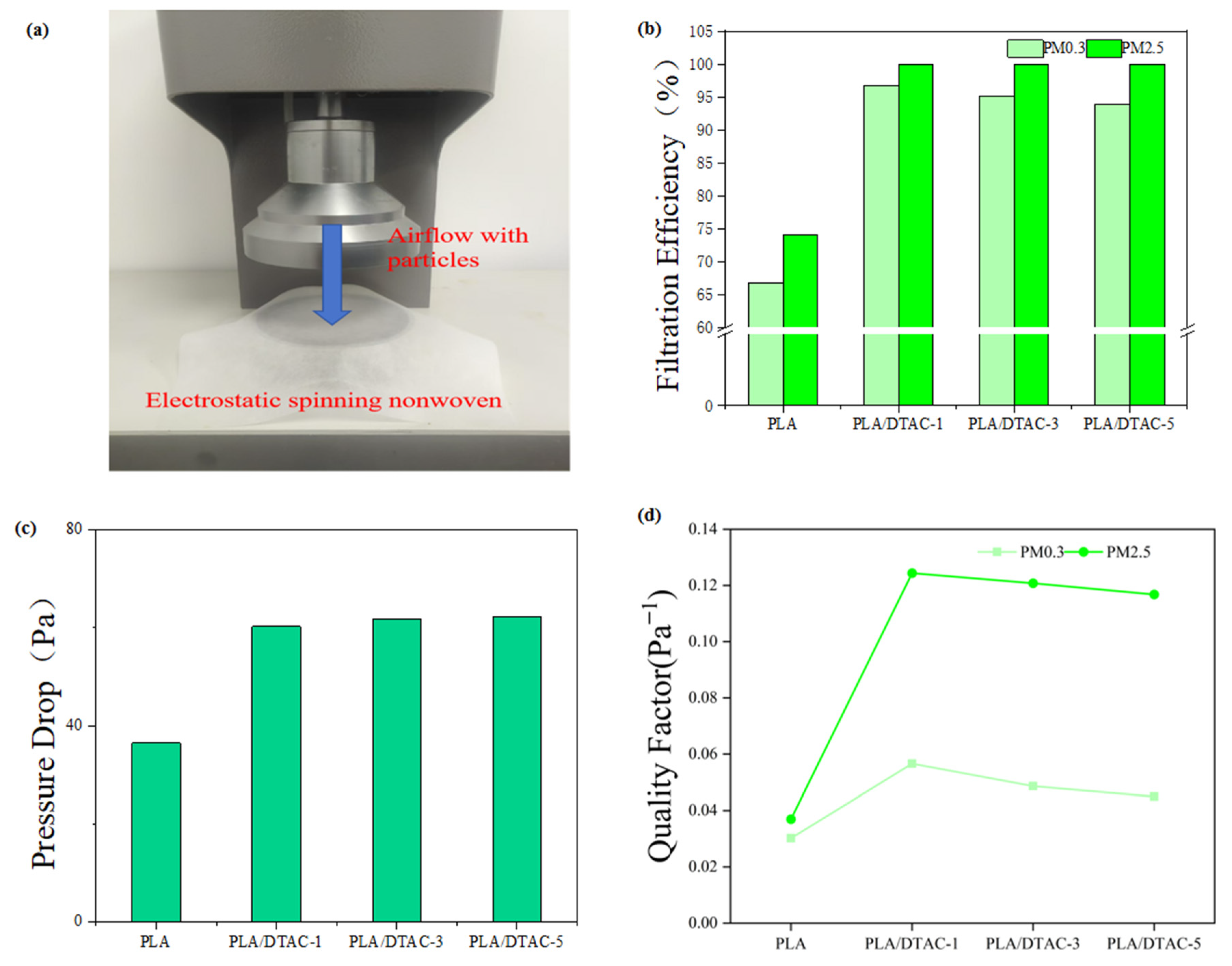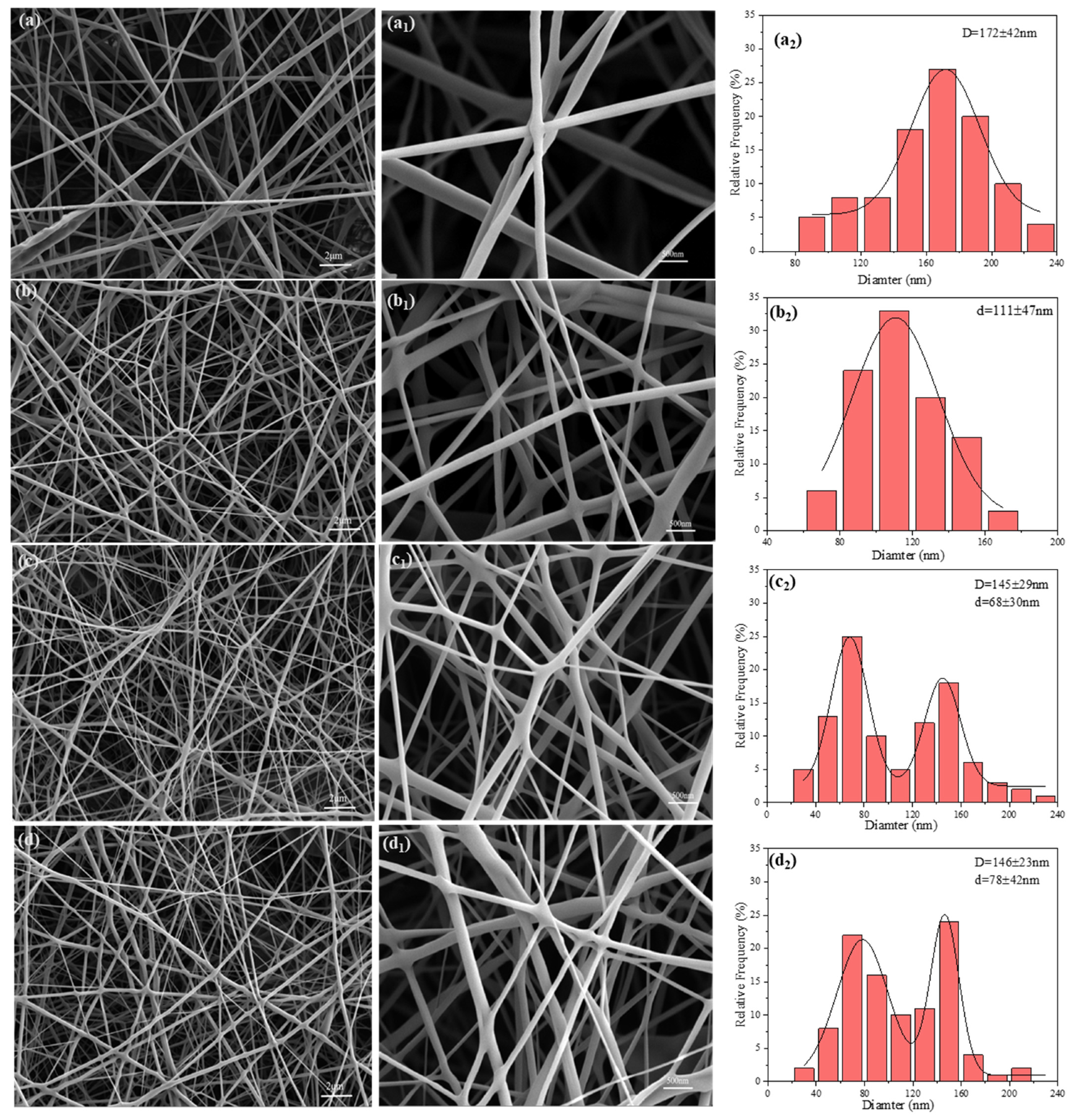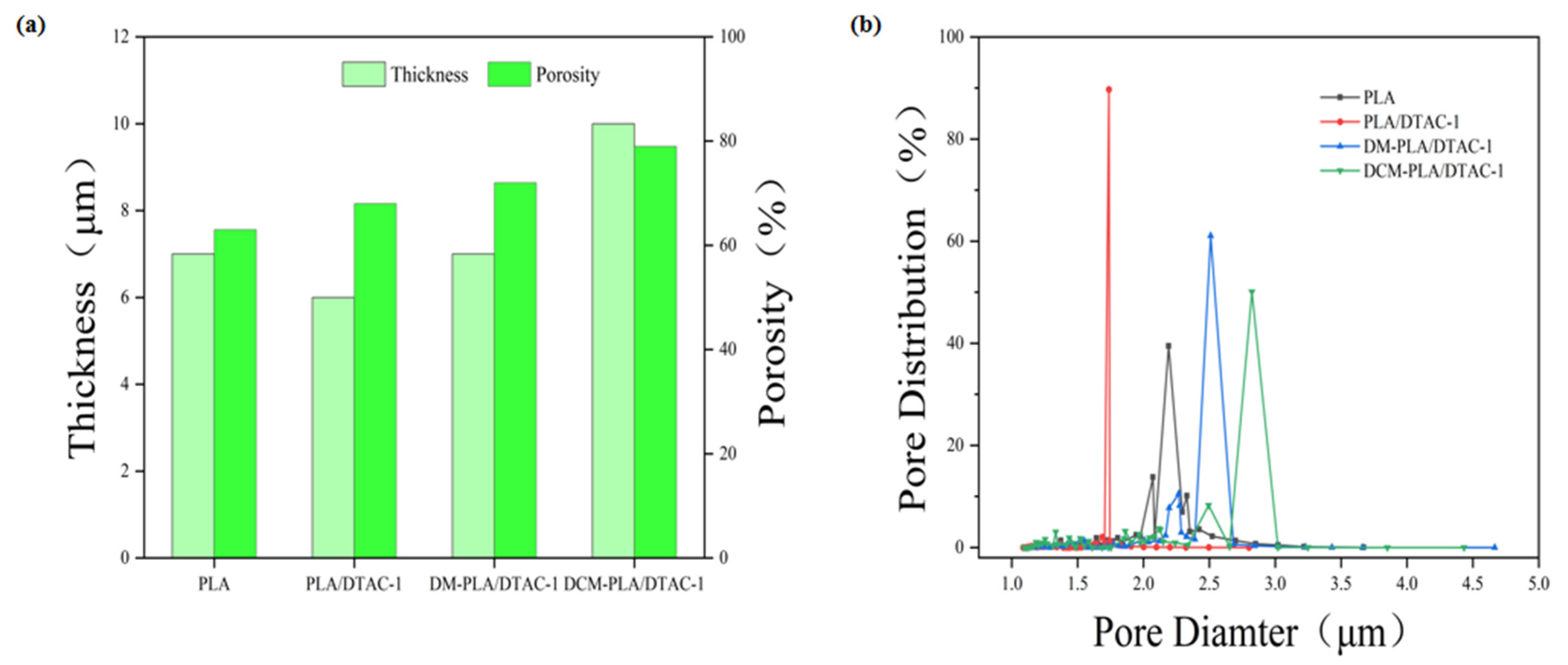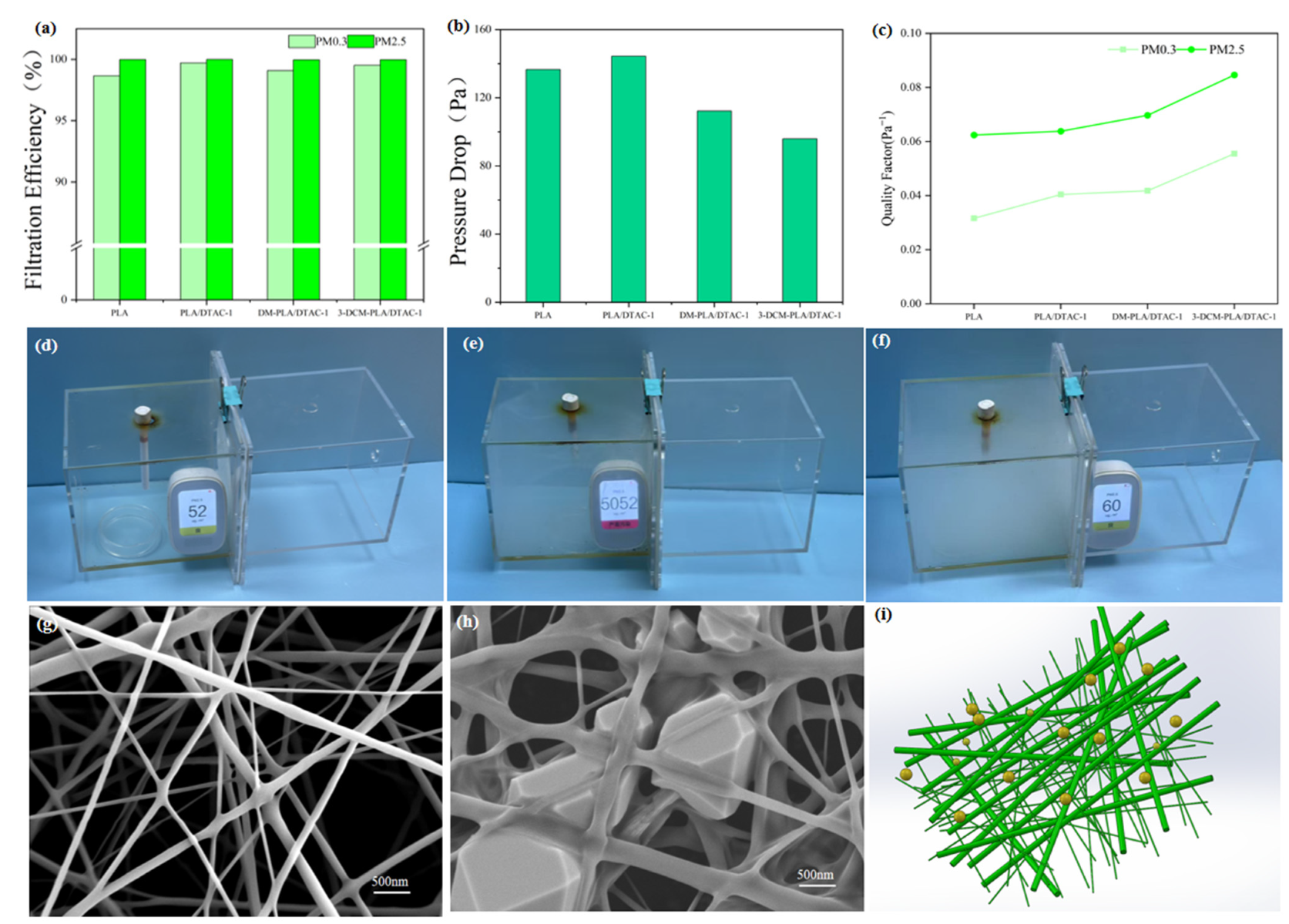Electrospun PLA/DTAC Bicomponent Membranes for Low-Resistance and Antibacterial Air Filtration
Abstract
1. Introduction
2. Materials and Methods
2.1. Materials
2.2. Preparation of Bimodal Fiber Membrane
2.3. Characterization
2.4. Assessment of Filtration Performance
2.5. Evaluation of Antibacterial Performance
3. Results and Discussion
3.1. Design of Bimodal PLA Structure
3.2. Morphological Observation of Membranes
3.3. Morphology and Structural Analysis
3.4. Effect of Bimodal Diameter Difference on Filtration
3.5. Filtration Performance and Mechanism
3.6. Load Performance and Durability
3.7. Antimicrobial Performance
4. Conclusions
Author Contributions
Funding
Institutional Review Board Statement
Data Availability Statement
Acknowledgments
Conflicts of Interest
References
- Karim, N.; Afroj, S.; Lloyd, K.; Oaten, L.C.; Andreeva, D.V.; Carr, C.; Farmery, A.D.; Kim, I.-D.; Novoselov, K.S. Sustainable personal protective clothing for healthcare applications: A review. ACS Nano 2020, 14, 12313–12340. [Google Scholar] [CrossRef]
- Fan, F.; Lei, Y.; Li, L. Health damage assessment of particulate matter pollution in Jing-Jin-Jiregion of China. Environ. Sci. Pollut. Res. 2019, 26, 7883–7895. [Google Scholar] [CrossRef]
- Lam CY, K.; Zhang, Q.; Yin, B.; Huang, Y.; Wang, H.; Yang, M.; Wong, S.H.D. Recent advances in two-dimensional transition metal dichalcogenide nanocomposites biosensors for virus detection before and during COVID-19 outbreak. J. Compos. Sci. 2021, 5, 190. [Google Scholar] [CrossRef]
- Maleki, M.; Anvari, E.; Hopke, P.K.; Noorimotlagh, Z.; Mirzaee, S.A. An updated systematic review on the association between atmospheric particulate matter pollution and prevalence of SARS-CoV-2. Environ. Res. 2021, 195, 110898. [Google Scholar] [CrossRef]
- Rujitanaroj, P.; Pimpha, N.; Supaphol, P. Preparation, characterization, and antibacterial properties of electrospun polyacrylonitrile fibrous membranes containing silver nanoparticles. J. Appl. Polym. Sci. 2010, 116, 1967–1976. [Google Scholar] [CrossRef]
- Ertek, D.A.; Sanli, N.O.; Menceloglu, Y.Z.; Seven, S.A. Environmentally friendly, antibacterial materials from recycled keratin incorporated electrospun PLA films with tunable properties. Eur. Polym. J. 2023, 185, 111804. [Google Scholar] [CrossRef]
- Wang, G.; Xu, Z.; Qi, Y.; Fang, Y.; Ning, G.; Ye, J. Electrospun nanofibrous membranes with antimicrobial activity for air filtration. Chin. Chem. Lett. 2024, 35, 109503. [Google Scholar] [CrossRef]
- Lin, X.; Sun, W.; Lin, M.; Chen, T.; Duan, K.; Lin, H.; Zhang, C.; Qi, H. Bicomponent core/sheath melt-blown fibers for air filtration with ultra-low resistance. RSC Adv. 2024, 14, 14100–14113. [Google Scholar] [CrossRef]
- Halamicek, R.; Wiesmann, C.; Kröner, R.; Eber, M.; Bogdan, C.; Schubert, D.W. Influence of different treatment conditions on the filtration performance of conventional electret melt blown non-woven and novel nano FFP2 masks. PLoS ONE 2023, 18, e0291679. [Google Scholar] [CrossRef]
- Jafari, M.; Shim, E.; Joijode, A. Fabrication of Poly (lactic acid) filter media via the meltblowing process and their filtration performances: A comparative study with polypropylene meltblown. Sep. Purif. Technol. 2021, 260, 118185. [Google Scholar] [CrossRef]
- Yang, C.; Jiang, X.; Gao, X.; Wang, H.; Li, L.; Hussain, N.; Xie, J.; Cheng, Z.; Li, Z.; Yan, J.; et al. Saving 80% polypropylene in facemasks by laser-assisted melt-blown nanofibers. Nano Lett. 2022, 22, 7212–7219. [Google Scholar] [CrossRef]
- Lee, K.; Kim, D.; Kim, J. Computational modeling of multiscale air filter media consisting of nano-and microfibers. ACS Appl. Nano Mater. 2023, 6, 9415–9425. [Google Scholar] [CrossRef]
- Gao, D.; Zhao, R.; Yang, X.; Chen, F.; Ning, X. Bicomponent PLA nanofiber nonwovens as highly efficient filtration media for particulate pollutants and pathogens. Membranes 2021, 11, 819. [Google Scholar] [CrossRef]
- Lin, M.; Shen, J.; Wang, B.; Chen, Y.; Zhang, C.; Qi, H. Preparation of fluffy bimodal conjugated electrospun poly (lactic acid) air filters with low pressure drop. RSC Adv. 2023, 13, 30680–30689. [Google Scholar] [CrossRef]
- Yang, Y.; Li, X.; Zhou, Z.; Qiu, W.; Chen, W.; Huang, J.; Cai, W.; Qin, X.; Lai, Y. Ultrathin, ultralight dual-scale fibrous networks with high-infrared transmittance for high-performance, comfortable and sustainable PM0. 3 filter. Nat. Commun. 2024, 15, 1586. [Google Scholar] [CrossRef]
- Cojocaru, V.; Frunzaverde, D.; Miclosina, C.O.; Marginean, G. The influence of the process parameters on the mechanical properties of PLA specimens produced by fused filament fabrication—A review. Polymers 2022, 14, 886. [Google Scholar] [CrossRef]
- Fromager, B.; Marhuenda, E.; Louis, B.; Bakalara, N.; Cambedouzou, J.; Cornu, D. Recent Advances in Electrospun Fibers for Biological Applications. Macromol 2023, 3, 569–613. [Google Scholar] [CrossRef]
- Fadil, F.; Affandi ND, N.; Misnon, M.I.; Bonnia, N.N.; Harun, A.M.; Alam, M.K. Review on electrospun nanofiber-applied products. Polymers 2021, 13, 2087. [Google Scholar] [CrossRef]
- Zhao, L.; Duan, G.; Zhang, G.; Yang, H.; He, S.; Jiang, S. Electrospun functional materials toward food packaging applications: A review. Nanomaterials 2020, 10, 150. [Google Scholar] [CrossRef]
- More, N.; Avhad, M.; Utekar, S.; More, A. Polylactic acid (PLA) membrane—Significance, synthesis, and applications: A review. Polym. Bull. 2023, 80, 1117–1153. [Google Scholar] [CrossRef]
- Maleki, H.; Azimi, B.; Ismaeilimoghadam, S.; Danti, S. Poly (lactic acid)-based electrospun fibrous structures for biomedical applications. Appl. Sci. 2022, 12, 3192. [Google Scholar] [CrossRef]
- Meyva-Zeybek, Y.; Kaynak, C. Electrospinning of PLA and PLA/POSS nanofibers: Use of Taguchi optimization for process parameters. J. Appl. Polym. Sci. 2021, 138, 49685. [Google Scholar] [CrossRef]
- Liu, H.; Zhang, S.; Liu, L.; Yu, J.; Ding, B. A fluffy dual-network structured nanofiber/net filter enables high-efficiency air filtration. Adv. Funct. Mater. 2019, 29, 1904108. [Google Scholar] [CrossRef]
- Shao, Z.; Chen, Y.; Jiang, J.; Xiao, Y.; Kang, G.; Wang, X.; Li, W.; Zheng, G. Multistage-split ultrafine fluffy nanofibrous membrane for high-efficiency antibacterial air filtration. ACS Appl. Mater. Interfaces 2022, 14, 18989–19001. [Google Scholar] [CrossRef]
- Rasouli, M.; Pirsalami, S.; Zebarjad, S.M. Study on the formation and structural evolution of bead-on-string in electrospun polysulfone mats. Polym. Int. 2020, 69, 822–832. [Google Scholar] [CrossRef]
- Shen, W.; Ao, F.; Wang, L.; Ge, X.; Ren, H.; Fan, G.; Ning, Y. Effects on ultrafine fibers with electrospun bead jet method based on 3-arm PLA. Mater. Lett. 2020, 261, 127137. [Google Scholar] [CrossRef]
- Liu, H.; Zhang, S.; Liu, L.; Yu, J.; Ding, B. High-performance PM0. 3 air filters using self-polarized electret nanofiber/nets. Adv. Funct. Mater. 2020, 30, 1909554. [Google Scholar] [CrossRef]
- Zhang, S.; Liu, H.; Tang, N.; Zhou, S.; Yu, J.; Li, B.; Ding, B. Spider-web-inspired PM0. 3 filters based on self-sustained electrostatic nanostructured networks. Adv. Mater. 2020, 32, 2002361. [Google Scholar] [CrossRef]
- Zhao, Y.; Jia, M.; Wang, X.; Sun, X.; Li, Z. Enhanced output performance piezoelectric nanogenerators based on highly polarized PVDF/TBAHP tree-like nanofiber membranes for energy harvesting. Polymer 2024, 293, 126681. [Google Scholar] [CrossRef]
- Zhang, K.; Li, Z.; Kang, W.; Deng, N.; Yan, J.; Ju, J.; Liu, Y.; Cheng, B. Preparation and characterization of tree-like cellulose nanofiber membranes via the electrospinning method. Carbohydr. Polym. 2018, 183, 62–69. [Google Scholar] [CrossRef]
- Zheng, G.; Shao, Z.; Chen, J.; Jiang, J.; Zhu, P.; Wang, X.; Li, W.; Liu, Y. Self-Supporting Three-Dimensional Electrospun Nanofibrous Membrane for Highly Efficient Air Filtration. Nanomaterials 2021, 11, 2567. [Google Scholar] [CrossRef]
- Cao, Q.; Meng, X.; Tan, S.; Xin, Z.; Turng, L.; Li, J.; Yao, Z.; Zhai, Z.; Duan, R. Electrospun bead-in-string fibrous membrane prepared from polysilsesquioxane-immobilising poly (lactic acid) with low filtration resistance for air filtration. J. Polym. Res. 2020, 27, 1–13. [Google Scholar] [CrossRef]
- Tang, M.; Jiang, L.; Wang, C.; Li, X.; He, X.; Li, Y.; Liu, C.; Wang, Y.; Gao, J.; Xu, H. Bioelectrets in electrospun bimodal poly (lactic acid) fibers: Realization of multiple mechanisms for efficient and long-term filtration of fine PMs. ACS Appl. Mater. Interfaces 2023, 15, 25919–25931. [Google Scholar] [CrossRef]
- Batra, R.; Purwar, R.; Kulanthaivel, S.; Mishra, P. Cetyl Trimethyl Ammonium Bromide Modified Montmorillonite-Doped Tasar Silk Fibroin/Polyvinyl Alcohol Blend 3D Nanowebs for Tissue Engineering Applications. Macromol. Mater. Eng. 2021, 306, 2100450. [Google Scholar] [CrossRef]
- Xie, X.; Li, D.; Chen, Y.; Shen, Y.; Yu, F.; Wang, W.; Yuan, Z.; Morsi, Y.; Wu, J.; Mo, X. Conjugate electrospun 3D gelatin nanofiber sponge for rapid hemostasis. Adv. Healthc. Mater. 2021, 10, 2100918. [Google Scholar] [CrossRef]
- Zhang, S.; Liu, H.; Tang, N.; Ge, J.; Yu, J.; Ding, B. Direct electronetting of high-performance membranes based on self-assembled 2D nanoarchitectured networks. Nat. Commun. 2019, 10, 1458. [Google Scholar] [CrossRef]
- Espinoza-Montero, P.J.; Montero-Jiménez, M.; Rojas-Quishpe, S.; Leon, C.D.A.; Heredia-Moya, J.; Rosero-Chanalata, A.; Orbea-Hinojosa, C.; Pineiros, J.L. Nude and modified electrospun nanofibers, application to air purification. Nanomaterials 2023, 13, 593. [Google Scholar] [CrossRef]
- Quan, Z.; Zu, Y.; Wang, Y.; Zhou, M.; Qin, X.; Yu, J. Slip Effect Based Bimodal Nanofibrous Membrane for High-Efficiency and Low-Resistance Air Purification. Sep. Purif. Technol. 2021, 275, 119258. [Google Scholar] [CrossRef]
- Mortazavi Milani, H.; Van Neste, B.; Cosaert, E.; Poelman, D. Assessing the Stability and Photocatalytic Efficiency of a Biodegradable PLA-TiO2 Membrane for Air Purification. Adv. Sustain. Syst. 2024, 9, 2400594. [Google Scholar] [CrossRef]
- Karabulut, H.; Unal, S.; Ulag, S.; Ficai, A.; Ficai, D.; Gunduz, Q. Mapping the Influence of Solvent Composition over the Characteristics of Polylactic Acid Nanofibers Fabricated by Electrospinning. ChemistrySelect 2024, 9, e202301142. [Google Scholar] [CrossRef]
- Juhasz, A.G.; Molnar, K.; Idrissi, A.; Jedlovszky-Hajdu, A. Salt induced fluffy structured electrospun fibrous matrix. J. Mol. Liq. 2020, 312, 113478. [Google Scholar] [CrossRef]
- Shao, Z.; Kang, G.; Chen, H.; Jiang, J.; Wang, X.; Li, W.; Liu, Y.; Zheng, G. Preparation, characterization, and air filtration property of electrospun bimodal fibrous membrane based on low conductivity blended polymers solution. Mater. Today Commun. 2023, 34, 105014. [Google Scholar] [CrossRef]
- Jaganathan, S.; Tafreshi, H.V.; Pourdeyhimi, B. On the pressure drop prediction of filter media composed of fibers with bimodal diameter distributions. Powder Technol. 2008, 181, 89–95. [Google Scholar] [CrossRef]
- Zhang, X.; Xu, Y.; Zeng, Y. Efficient, breathable and biodegradable filter media for face masks. Fibers Polym. 2023, 24, 1613–1621. [Google Scholar] [CrossRef]
- Zhu, C.; Lin, C.H.; Cheung, C.S. Inertial impaction-dominated fibrous filtration with rectangular or cylindrical fibers. Powder Technol. 2000, 112, 149–162. [Google Scholar] [CrossRef]
- Cheng, Y.; Wang, C.; Zhong, J.; Lin, S.; Xiao, Y.; Zhong, Q.; Jinag, H.; Wu, N.; Li, W.; Chen, S.; et al. Electrospun polyetherimide electret nonwoven for bi-functional smart face mask. Nano Energy 2017, 34, 562–569. [Google Scholar] [CrossRef]
- Bull, K. Cabin air filtration: Helping to protect occupants from infectious diseases. Travel Med. Infect. Dis. 2008, 6, 142–144. [Google Scholar] [CrossRef]
- Cho, Y.; Son, Y.; Ahn, J.; Lim, H.; Aha, S.; Lee, J.; Bae, P.K.; Kim, I.-D. Multifunctional filter membranes based on self-assembled core–shell biodegradable nanofibers for persistent electrostatic filtration through the triboelectric effect. ACS Nano 2022, 16, 19451–19463. [Google Scholar] [CrossRef]








| Sample | Positive PLA Liquid Supply Rate (mL/h) | Positive PLA/DTAC Liquid Supply Rate (mL/h) |
|---|---|---|
| 3.5-DCM-PLA/DTAC-1 | 3.5 | 0.5 |
| 3-DCM-PLA/DTAC-1 | 3 | 1 |
| DCM-PLA/DTAC-1 | 2 | 2 |
| 1-DCM-PLA/DTAC-1 | 1 | 3 |
| 0.5-DCM-PLA/DTAC-1 | 0.5 | 3.5 |
Disclaimer/Publisher’s Note: The statements, opinions and data contained in all publications are solely those of the individual author(s) and contributor(s) and not of MDPI and/or the editor(s). MDPI and/or the editor(s) disclaim responsibility for any injury to people or property resulting from any ideas, methods, instructions or products referred to in the content. |
© 2025 by the authors. Licensee MDPI, Basel, Switzerland. This article is an open access article distributed under the terms and conditions of the Creative Commons Attribution (CC BY) license (https://creativecommons.org/licenses/by/4.0/).
Share and Cite
Wang, X.; Yuan, Q.; Qian, Q.; Wang, J.; Zhang, C.; Qi, H. Electrospun PLA/DTAC Bicomponent Membranes for Low-Resistance and Antibacterial Air Filtration. Polymers 2025, 17, 767. https://doi.org/10.3390/polym17060767
Wang X, Yuan Q, Qian Q, Wang J, Zhang C, Qi H. Electrospun PLA/DTAC Bicomponent Membranes for Low-Resistance and Antibacterial Air Filtration. Polymers. 2025; 17(6):767. https://doi.org/10.3390/polym17060767
Chicago/Turabian StyleWang, Xianzhong, Qiumiao Yuan, Qiaonan Qian, Jingchao Wang, Chuyang Zhang, and Huan Qi. 2025. "Electrospun PLA/DTAC Bicomponent Membranes for Low-Resistance and Antibacterial Air Filtration" Polymers 17, no. 6: 767. https://doi.org/10.3390/polym17060767
APA StyleWang, X., Yuan, Q., Qian, Q., Wang, J., Zhang, C., & Qi, H. (2025). Electrospun PLA/DTAC Bicomponent Membranes for Low-Resistance and Antibacterial Air Filtration. Polymers, 17(6), 767. https://doi.org/10.3390/polym17060767






